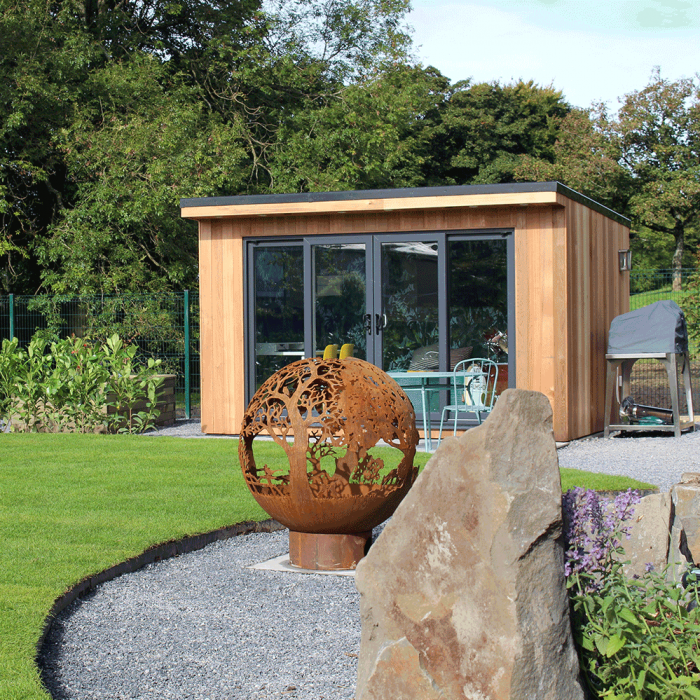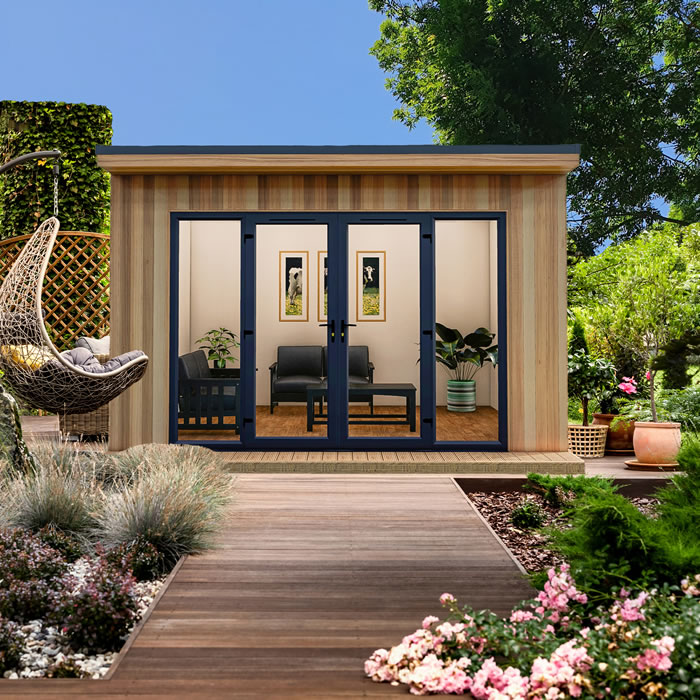Good Reasons On Planning Permission On Garden Outhouses
Good Reasons On Planning Permission On Garden Outhouses
Blog Article
What Kind Of Planning Permit Are You Required To Obtain In Order To Change The Purpose Of Your Garden Room Or Other Area.?
The concept of "change in use" is crucial when building garden offices, conservatories or outhouses. These are the most important factors to consider when applying for a permit related to a change of usage changing from non-residential to residential:
Planning permission is generally required when you want to convert an existing non-residential property (such as a garage, agricultural structure or garden office) to a home or garden office. This is because there could have to be a change of use class.
Garden Rooms as Living Space:
The use of a garden space as a separate living accommodation (e.g. or a guest house or rental unit) is considered to be a change in use. Planning permission is required to ensure that the structure is in compliance with the requirements for residential properties and standards.
Business Use
Planning permission may be required If you are planning to use your garden room, conservatory or extension as a business (e.g. as an office for home-based businesses that have frequent visitors or employees). The effect of the project on the surrounding area like noise, traffic and parking, might require planning permission.
Educational or Community Use:
Planning permission is required to transform a garden structure into a space for education or for community (such as a meeting room or a classroom). The local authority assesses the location's suitability and its impacts on the surrounding areas.
Impact on Infrastructure Local:
In general, any alteration to usage that has an impact on local infrastructure (such as roads, drainage or other public services) will require planning permission. This will be evaluated by the local planning authority at the time of the process of applying for permission.
Dual Use
In the case of properties with mixed uses (e.g. commercial, residential, and commercial) A permit for planning is typically required to clearly define the different uses.
A Boost in Footfall
If the proposed change in use is likely to increase footfall or traffic (e.g. the conversion of the garden into a smaller retail space), planning permission is required to consider any potential impact on the local zone.
Building Regulations Conformity:
Although not strictly an issue planning permissions, any changes in use must adhere to construction regulations that address security as well as health and energy efficiency requirements. This is particularly true for conversions of non-habitable spaces into habitable spaces.
Environmental Impact:
Planning approval is required for all modifications to the use of land that could have an impact on the environment. For example, converting agricultural land into residential use. The application could require an environmental evaluation.
Effect on Community and Amenities:
It is essential to consider the effect that this change has on the local amenities in the area and the overall character of the area. For instance, to transform a room within the garden to a café shop requires approval for planning. This is to ensure that it is compatible with community plans while preserving the amenities of the area.
Designated Zones
Changes in usage are strictly restricted in areas that are designated as National Parks or Areas of Outstanding Natural Beauty. This is to protect the character and beauty of these areas. Planning permission is crucial in these instances.
Local Planning Policies
Local authorities for planning have specific policies regarding change of use, which can vary significantly. It's important to consult these policies to understand the requirements for changes and what requirements must be fulfilled.
In short Planning permission is usually required for any significant change of use of a garden room conservatory, outhouse, garden office, or extension. It guarantees that the new use will be appropriate for the site, comply with national and local policies, and address any impact that could be a threat to the environment or community. A prompt consultation with the local planning authority is crucial to determine the specific requirements for the project and obtain approvals. See the most popular what is conservatory for site examples including garden rooms, insulated garden buildings, do i need planning permission for a garden room with toilet, garden office hertfordshire, garden outhouses, myouthouse, best electric heater for cabin, ground screws vs concrete, what size garden room without planning permission, Tring garden rooms and more.
What Planning Permission Is Required For Garden Rooms Etc In Terms Of Environmental Impact?
The environmental impact of constructing garden rooms, conservatories or outhouses as well as extension of garden offices or extensions could be significant in determining the necessity for a planning permit. Be aware of these environmental issues:
Planning permission is needed when the structure is likely to have an impact on wildlife habitats such as hedgerows, trees or ponds. To determine and limit the impact of biodiversity, an ecological assessment may be required.
Habitats and Species that are protected
The site needs to be ratified to develop if it is home to or is in close proximity to species that are protected (e.g. Bats, Newts, etc.)) or has habitats that are protected (e.g. Sites of Special Scientific Interest SSSI). To protect them, special measures must be implemented.
Tree Preservation Orders
Permission is required to remove or alter the condition of trees that are covered by TPOs. The local council will be able to assess the impacts, and could require that replacement plantings be made or other mitigation.
Risk of flooding and Water Management Risk and Water Management
Planning permission is required for developments near or in flood-prone zones. It may be necessary to carry out a flood risk analysis in order to make sure that the structure isn't vulnerable to flooding and includes drainage solutions.
Sustainable Construction Practices
You may need approval for your plans to ensure sustainable construction and materials. This includes considering insulation and energy efficiency as well as carbon footprint of building materials.
Surface Water Runoff and Drainage:
One of the most important aspects to consider for the environment is how the proposed structure will impact drainage and runoff from surface water. The planning permission will ensure that the drainage system is in place and prevents flooding or logging.
Land and soil stability:
If the proposed construction will impact soil quality or land stability the need for planning permission. This includes potential issues like subsidence or soil erosion, especially on sloped sites.
Air Quality:
Planning permission is required for developments that could impact the local air quality such as those that are located close to industrial areas or major highways. This is in order to ensure that the levels of air pollution remain within acceptable levels. Also, mitigation measures will be implemented.
Noise Pollution:
The planning permission is required when you plan to use your extension to your garden or the room in a way that will generate significant sound (e.g. a music or workshop studio). The local authority evaluates the level of noise and potential effects on the environment and neighbors.
Waste Management:
A well-organized waste management system in both construction and after is crucial. Planning permission will ensure that there are sufficient facilities for recycling and waste disposal while minimizing the environmental impacts.
Energy Efficiency
The planning permit could include conditions for energy efficiency like solar panels, high-performance glass or other green technologies. This can reduce the carbon footprint of the building.
Environmental Regulations
Environmental protection laws, including the UK Environmental Protection Act, must be followed by developments. Planning approval ensures that all standards are met in addition to the development being sustainable for the environment.
The planning permission granted to gardens, conservatories, garden rooms and outhouses should also consider a wide range of impacts on the natural environment. Consult the local authority for planning as early as you can during the planning stage to make sure you are aware of the requirements specific to your project. View the best conservatory what is for site examples including outhouse garden, garden room permitted development, garden rooms in St Albans, garden room conservatory, composite garden rooms, outhouse builders, garden buildings , what size garden room without planning permission, Tring garden rooms, costco outbuildings and more.![]()
What Is The Planning Permission Needed For Garden Rooms, Or Other Areas., In Terms Utilities And Infrastructure
When planning to build gardens, conservatories, outhouses, garden offices or extensions, utilities and infrastructure factors are essential and may affect the need for planning permission. These are the most important factors to be considered: Water Supply & Drainage
Planning permission could be required if the new structure needs connections to the drainage or water supply systems. Local water authorities could be required to assess any impact on the local sewage and water systems.
Gas and Electricity:
If the proposed structure will require connection to gas and electricity A planning approval could be needed. The connection must comply with building regulations and safety requirements.
Utility Easements:
The proposed structure must be located within utility easements (areas specifically designated for utility lines and infrastructure), planning permission may be required. It may be necessary for the local utility company to authorize construction within these areas.
Septic tanks and Sewage Systems
If a building is being constructed that requires the use of a septic treatment facility, or even a small septic tank on site, then planning permission is required. Conformity with environmental regulations as well as health standards is vital to these systems.
Drainage & Surface Water Management
The planning permission is needed for the drainage of runoff and surface water from a brand new structure. To avoid erosion and flooding, as well as polluting water, it may be necessary that you implement specific measures.
Access to Utilities for Construction
In the event that construction requires access to utilities for a short period of time (such as water to be used for construction purposes) the planning permit may be required. Temporary connections have to meet environmental and safety standards.
Local impact on infrastructure:
To assess the impact on local infrastructure, such as roads, utilities and public services, etc., it is necessary to obtain a planning permit. The local authority will decide whether the infrastructure is capable of supporting the new development.
Recycling and waste management:
Planning permission could require conditions for recycling and waste disposal in the construction phase or even after. Adequate provisions for waste disposal and recycling have to be in place to reduce environmental impact.
Energy Efficiency as well as Renewable Energy
Installation of energy-efficient components or systems for renewable energy, such as solar panels and heat pumps, in new buildings might require planning permission. The codes for construction and environmental standards should be observed.
Telecommunications as well as Internet connectivity:
Planning permission might be required for a new building that requires internet or telecommunications. Compliance with regulations and standards for telecommunications infrastructure is essential.
Accessible via Roads and Footpaths
In some cases, it might be necessary to obtain planning permission prior to being able to build or modify the footpath. The compliance with safety standards and regulations regarding construction of footpaths and roads is essential.
Accessibility of the public transport system:
Planning permission is required when the proposed structure will impact public transport facilities such as railway stations or bus stations. Transport infrastructure for public use must conform to the regulations and standards.
In short, utilities and infrastructure factors are crucial in determining whether or not a planning permit is required to build extensions, garden rooms, outhouses, or garden offices. Early consultation with the local authority is crucial to ensure the compliance of all applicable regulations and standards. See the most popular cardio workouts welwyn for website tips including garden rooms hertfordshire, out house for garden, what size garden room without planning permission uk, outhouse builders, 4m x 4m garden room, out house, garden rooms near me, garden office electrics, outhouse builders, do you need planning permission for a garden room and more.